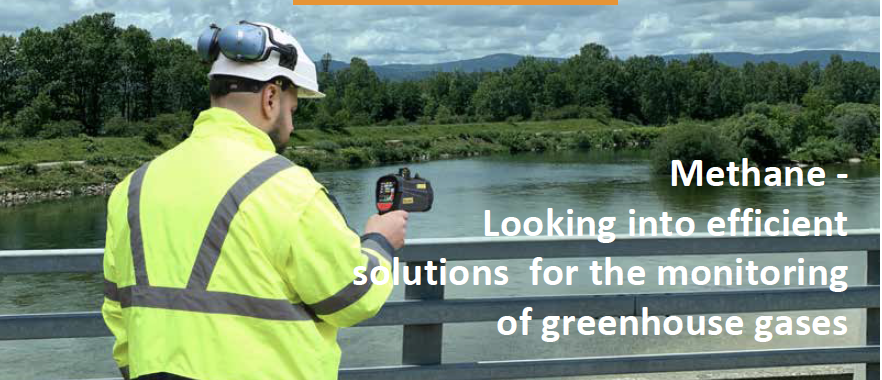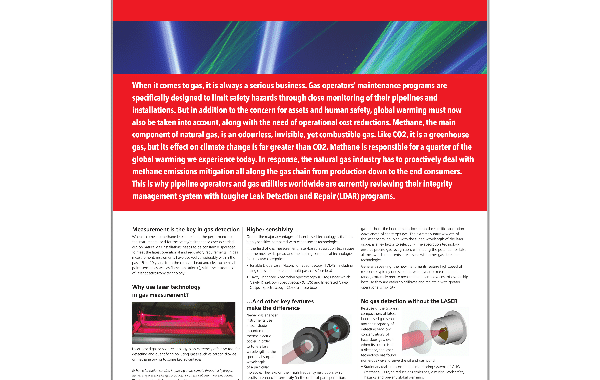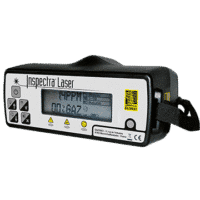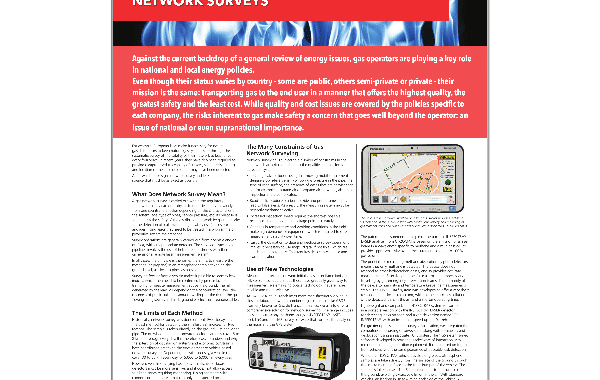Watch our new video showing the Gazoscan Remote Methane Detector:-
Category Archives: Articles
Methane – looking into efficient solutions for greenhouse gas monitoring
Methane leak monitoring for the biogas and natural gas industries
Methane leak monitoring for the biogas and natural gas industries - Far more sensitive, reliable and relevant solutions exist.
This is a GAZOMAT translation of the article published in the French Magazine Valeur Energie: Gazomat, Méthane – Quelles solutions pour une surveillance pertinente des gaz à effet de serre ? – Valeur énergie (valeurenergie.com)
Laser Focus Inspection
published in July of 2019
Gas distribution and transmission network operators face the difficult challenge of guaranteeing a continuous supply at a competitive price, while reducing hazards all along the chain down to the final consumers. More recently, their role in climate change has been pointed out, as methane gas emissions count for a quarter of the global warming experienced today.The solution exists. Network surveying is already part of the global maintenance policy of gas utilities. However, the issue is to reinforce gas emission prevention and remediation, using the right tools.The goal of a pipeline network inspection program is to identify gas leaks quickly and reliably, so as to eliminate those representing an immediate threat to safety and build the pipeline maintenance schedule. Using the right detection instruments is clearly a key factor in the process. Gas measurement technologies were initially based on flame ionization (FID), electrochemical sensors or semiconductors. Over the past 15 to 20 years, the introduction of optical technology has gradually changed the game, with the development of high performance laser-based instruments. The new technology is extremely effective in detecting and quantifying polluting gases such as carbon dioxide or methane, thanks to the principle of infrared absorption spectrometry.
Gas Detection: The Laser Approach
published in February of 2019
When it comes to gas, it is always a serious business. Gas operators’ maintenance programs are specifically designed to limit safety hazards through close monitoring of their pipelines and installations. But in addition to the concern for assets and human safety, global warming must now also be taken into account, along with the need of operational cost reductions. Methane, the main component of natural gas, is an odorless, invisible, yet combustible gas. Like CO2, it is a greenhouse gas, but its effect on climate change is far greater than CO2. Methane is responsible for a quarter of the global warming we experience today. In response, the natural gas industry has to proactively deal with methane emissions mitigation all along the gas chain from production down to the end consumers. This is why pipeline operators and gas utilities worldwide are currently reviewing their integrity management system with tougher Leak Detection and Repair (LDAR) programs.
Measurement Is The Key In Gas Detection
When it comes to methane leak detection, the performance of the instruments used for the safety/maintenance checks carried out on natural gas installations needs to be constantly upgraded to meet the latest operational and regulatory requirements. In gas measurement, instruments have evolved considerably within the past 15 to 20 years, from the catalytic bead and electrochemical point sensors as well as flame ionization (i), with the introduction of laser spectroscopy technology.
What is the best type of gas leak detector?
There are many different types of gas leak detectors on the market, so how does one go about choosing the best one for their organization? Today, operators rely on information gathered by a variety of combustible gas indicator (CGI) technologies. What these devices have in common is a basic principle which involves aspirating an air sample from the ground surface and bringing it into contact with a detector sensitive to gas molecules to obtain a gas concentration measurement. To be effective, detectors must meet a number of criteria:
- Detectors must be able to be calibrated and to hold that calibration.
- Detectors must be able to detect down to the target range.
- Calibrated to one type of gas, detectors must be highly selective with no false measures due to other gases.
- Response time. Detectors must respond as quickly as possible in order to provide the most precise leak location and to enable survey speed increase.
Depending on the need and budget, there are many options on the market to fit an organization’s need.
Semiconductor detectors are at a bargain price but limited in terms of measurement stability, sensitivity, and selectivity. Semi-conductor sensor detectors are made of metal oxide specially designed to react to gas. When the sensor is warmed to a high temperature and gas is present, the sensor surface absorbs oxygen molecules from the air sample, changing the electrical resistance characteristics of the sensor. This change is measured and gives the gas concentration level. These devices are most often used for localization rather than leak survey. Semi-conductor detectors are easy to use, but they are sensitive to many gasses and therefore not selective. They also require frequent calibration.
PROS | CONS |
Not expensive | Because sensitivity range is high, they are primarily used for localization. |
Fast response time | In high concentration, signal drifts |
Long lifespan | In high concentration, MOS sensor saturates- takes time to return to zero. |
Less sensitive than pellistors to poisoning | Reacts to a wide range of gasses |
More sensitive than pellistors to methane | Unstable, requires frequent calibration |
Explosimeters are another option. Explosimeters use pellistor sensors, which consist of a wire coated with a catalytic substance, platine. Based on its temperature, the electrical resistance of the wire changes. This resistance is measured and gives an image of the gas concentration. For the explosimeter measurement, the wire is heated by a current at 842°F (450°C). Because of the wire’s composition, the gas is oxidized in contact with the target gas. The reaction increases the temperature of the wire, changing its resistance. This combustion through an oxidizing process requires oxygen. The technique allows detection of a concentration ranging from 0 to 100% LEL with a precision of 2 %. If the concentration is higher than 100% LEL, the gas burns inside the measurement chamber and may impair the wire. As a result, these sensors must not be used to detect concentrations above 100% LEL.
PROS | CONS |
Detects all flammable compounds | Not selective |
Measurement sensitivity (from 50ppm CH4) | Frequent verification & calibration required |
Wide measurement range | Limited lifespan |
Not sensitive to shocks and falls | Can only measure up to gas LEL |
Electricity consumption relatively small | Non-linear measurement beyond 3-4% CH4 |
For higher concentrations, catharometer sensors are most suitable. The sensor is composed of two wires. One is in contact with the target gas and the other with a reference clean gas. This sensor relies on the thermal conductivity differences from one gas to another. For example, methane conducts twice as well as air. So when the sensor is in contact with the target gas, the equilibrium temperature will be broken and its resistance will change. The measurement of resistance will give a concentration ranging from 1% volume gas to 100% volume gas.
PROS | CONS |
Low cost | Not very sensitive |
Long lifespan | Adapted to a very limited number of gases |
Short response time | Non-linear response |
Reproducible measurements | Cannot be used in presence of two different gases |
Not sensitive to shocks and falls | Frequent calibrations required |
Combining both sensor types in one unit as in the explosimenter-catharometer detectors (ECDs), prevents damage to the explosimeter sensor. The main advantages are stability, prevision, and insensitivity to humidity. The main drawbacks are that the combination unit is not selective, and that sensitivity is not as high as with other detectors. Explosion-proof explosimeter-catharometer units are used in hazardous environments for on-foot detection and localization.
Optical detectors, a more recent choice, is based on a gas molecule’s property of absorbing radiation. The absorption spectrum of a molecule, which is specific to each gas, ensures identification of the molecule that is interacting with the light source which could be an incandescent bulb, a microelectromechanical (MEM) system, a light-emitting diode (LED, or a laser beam. The objective is to match the wavelength of the light source with a relevant portion of the electromagnetic spectrum of the molecule and to measure the strongest variation in the intensity of the transmitted light. One example of optical technology is the open path barrier system which uses an infrared light and an optical filter. In the case of detection by vehicle, the beam of infrared light is spread across the front of the vehicle and an optical filter, placed at one end of the beam, records the intensity. This enables gas detection at the ppm level and eliminates the need for sampling equipment.
PROS | CONS |
Relative selectivity to methane | Detects methane only |
High sensitivity, reacts to 1ppm | Water vapor absorbs infrared rays and interferes with methane measurements |
Wide working range temperature | Limited measurement range |
Not sensitive to dust | Measurement in ppm per meter |
Simplified maintenance | Dirt, mud deposits cause a sensitivity loss of optics – must be cleaned regularly. |
Another example is the multipass measurement cell, which uses a laser beam to analyze the gas concentration level within an air sample. This system detects measurements ranging from 0ppm to 100 % volume gas.
PROS | CONS |
Higher selectivity and sensitivity to methane | Expensive |
Insensitivity to other hydrocarbons, chemicals, and alcohol | The laser cannot absorb water or dust |
Physical measurements | Measures methane only unless adapted |
Does not modify the gas sample |
|
Not sensitive to flow fluctuations |
|
Choosing a gas leak detector really comes down to finding one that best fits the need. If you are unsure about which type of detector is best for your survey and localization situation, contact us for a free consultation.
No Gas Leak Goes Undetected
published in July of 2017
With more than 2.4 million miles of natural gas pipeline running underground in the U.S. alone, pipeline leak inspection represents a huge and challenging task for American gas operators. GAZOMAT, as an active partner of major gas distribution companies around the world, understands these challenges. With over 25 years of experience in the development, manufacturing and servicing of electronic detection equipment for the survey of gas distribution and transmission networks, as well as for operator protection in hazardous environments GAZOMAT is a specialist. GAZOMAT’s reputation for quality and reliability is recognized throughout Europe and around the globe via an extensive distribution network. Expanding further, GAZOMAT is now present in the U.S., with offices and production facility in California, offering local support. With its policy of continued innovation, GAZOMAT aims at providing advanced cost efficient solutions.
A Fresh Approach to Natural Gas Network Surveys
published in May of 2017
Against the current backdrop of a general review of energy issues, gas operators are playing a key role in national and local energy policies. Even though their status varies by country - some are public, others semi-private or private - their mission is the same: transporting gas to the end user in a manner that offers the highest quality, the greatest safety and the least cost. While quality and cost issues are covered by the policies specific to each company, the risks inherent to gas make safety a concern that goes well beyond the operator: an issue of national or even supranational importance.
What is LDAR?
What is Leak Detection and Repair (LDAR?)

What is LDAR?
Leak detection and repair (LDAR) is the process of surveying, identifying, and repairing natural gas leaks. This process is put into practice at a variety of facilities such as chemical, refineries, and oil and gas operations.
Regulations vary from state to state within the US. Therefore, each LDAR program must adapt its process accordingly. The US Environmental Protection Agency has established five basic elements of an LDAR program: identifying components, leak definition, monitoring components, repairing components, recordkeeping.
Why is LDAR important?
LDAR is important for numerous reasons. An efficient LDAR program:
- Reduces product losses for natural gas enterprises
- Increases safety for employees at natural gas sites
- Decreases methane exposure for individuals in the surrounding area
- Reduces emissions fees that some areas charge based on total emissions from a facility
- Aids facilities to avoid being targeted by regulation enforcement actions
An LDAR program is good for all; the natural gas enterprises, the employees at these facilities, and the community.
Now, what is Smart LDAR?
A well known study by the American Petroleum Institute found that over 90% of leaks (which are most often random) come from around 0.13% of the components. Smart LDAR is an alternative work practice, which uses optical technology to seek out those 0.13% of components. The goal of Smart LDAR is to focus on identifying and repairing larger leaks more efficiently with optical technology such as infrared and laser.
For more information on LDAR and Smart LDAR:
EPA: https://www.epa.gov/sites/production/files/2014-02/documents/ldarguide.pdf
EDF: https://www.edf.org/sites/default/files/find-and-fix-datu-research.pdf
Journal of Air & Waste Management: http://www.tandfonline.com/doi/pdf/10.3155/1047-3289.57.9.1050
Navigating the Gas Network
Navigating the Gas Network
Suzanne Najimi, Gazomat™ S.A.R.L. (France), discusses recent advances in gas leak detection for gas distribution pipelines.
published in January of 2011
Gas distribution companies worldwide are required to survey their networks on a periodic basis. Depending on the country and type of gas, this can range from every six months to every three years, or longer. Additionally, new safety regulations in Europe put gas companies under an increasing obligation to guarantee traceability of their surveys by providing precise location and dating of gas concentrations measured. Systematic leak detection is therefore part of the overall safety policy of gas distribution companies. Planned periodic detection programs also allow gas companies to understand their network conditions and to define economical maintenance, equipment and systems renewal policies. Aimed at the early identification of any network deterioration, systematic leak detection enables timely remedial action. As such, network leak surveys are part of any maintenance policy with the dual aim of increasing safety and maximizing efficiency. The main goals of gas leak detection are to identify potential gas leaks, confirm actual leaks and select those leaks that represent a threat to public safety and therefore require immediate repairs. Leak detection also strives to detect leaks at an early stage and prevent gas concentrations in air reaching the lower explosive limit (LEL) of 4.4% volume gas in air or 44 000 parts per million (ppm). At that level, the gas (usually methane) will ignite in the presence of a spark or flame.








